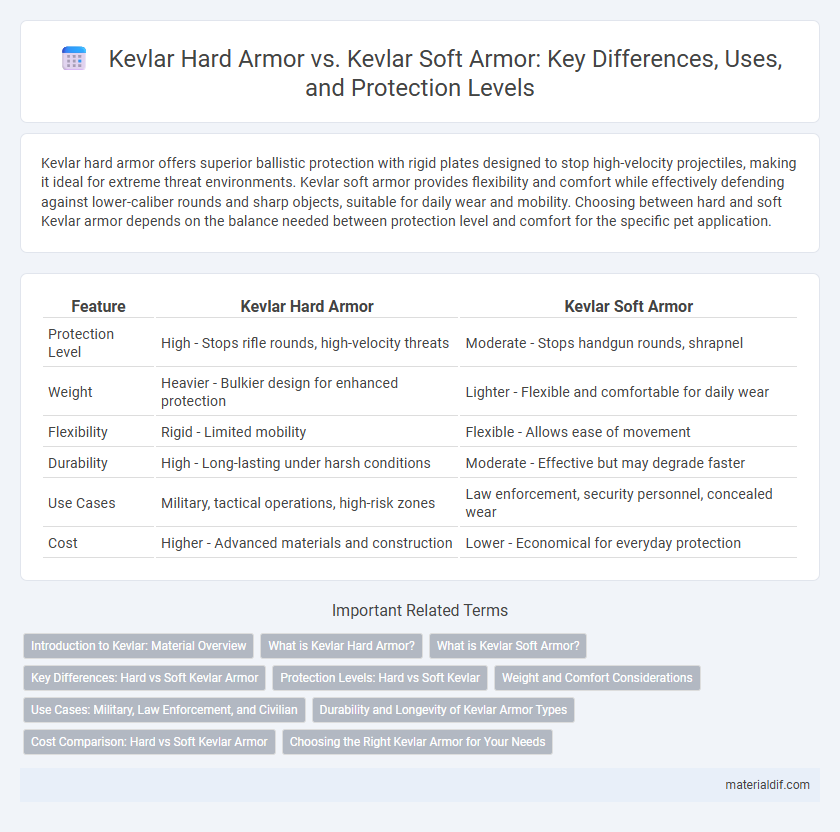Kevlar hard armor offers superior ballistic protection with rigid plates designed to stop high-velocity projectiles, making it ideal for extreme threat environments. Kevlar soft armor provides flexibility and comfort while effectively defending against lower-caliber rounds and sharp objects, suitable for daily wear and mobility. Choosing between hard and soft Kevlar armor depends on the balance needed between protection level and comfort for the specific pet application.
Table of Comparison
| Feature | Kevlar Hard Armor | Kevlar Soft Armor |
|---|---|---|
| Protection Level | High - Stops rifle rounds, high-velocity threats | Moderate - Stops handgun rounds, shrapnel |
| Weight | Heavier - Bulkier design for enhanced protection | Lighter - Flexible and comfortable for daily wear |
| Flexibility | Rigid - Limited mobility | Flexible - Allows ease of movement |
| Durability | High - Long-lasting under harsh conditions | Moderate - Effective but may degrade faster |
| Use Cases | Military, tactical operations, high-risk zones | Law enforcement, security personnel, concealed wear |
| Cost | Higher - Advanced materials and construction | Lower - Economical for everyday protection |
Introduction to Kevlar: Material Overview
Kevlar, a synthetic aramid fiber known for its exceptional strength-to-weight ratio, is widely used in ballistic protection through two primary forms: hard armor and soft armor. Hard armor typically incorporates Kevlar layers combined with rigid materials like ceramics or polyethylene to stop high-velocity rifle rounds, offering maximum protection at the expense of increased weight and reduced flexibility. Conversely, Kevlar soft armor consists of multiple woven or laminated Kevlar fabric layers designed to provide lightweight, flexible protection primarily against handgun threats and shrapnel.
What is Kevlar Hard Armor?
Kevlar hard armor consists of rigid plates made from advanced Kevlar fibers combined with other composite materials, designed to provide enhanced ballistic protection against high-velocity rifle rounds and shrapnel. Unlike soft armor, which is flexible and primarily effective against handgun threats, hard armor inserts offer superior resistance to penetration and blunt force trauma. This makes Kevlar hard armor essential for military personnel and law enforcement officers facing high-risk combat situations requiring maximum defense.
What is Kevlar Soft Armor?
Kevlar soft armor consists of lightweight, flexible layers of Kevlar fibers designed to provide protection against low-velocity handgun rounds and shrapnel. This type of armor is commonly used in bulletproof vests worn by law enforcement officers for daily protection without sacrificing mobility. Unlike Kevlar hard armor, soft armor lacks rigid plates and focuses on comfort and concealability while offering effective ballistic resistance against handgun threats.
Key Differences: Hard vs Soft Kevlar Armor
Kevlar hard armor consists of rigid plates made from layers of woven Kevlar fibers, designed to protect against high-velocity ballistic threats and blunt force trauma, while Kevlar soft armor is flexible and made from multiple layers of Kevlar fabric to provide lightweight protection primarily against handgun rounds. Hard Kevlar armor is commonly used in military and tactical settings requiring maximum impact resistance, whereas soft Kevlar armor is favored by law enforcement and security personnel for everyday wear due to its comfort and mobility. The key differences between hard and soft Kevlar armor center on their rigidity, threat protection levels, and application environments.
Protection Levels: Hard vs Soft Kevlar
Kevlar hard armor delivers higher protection levels, typically rated at NIJ Level III or IV, capable of stopping rifle rounds and ballistic threats. In contrast, Kevlar soft armor generally meets NIJ Level II or IIIA standards, effectively stopping handgun rounds and fragments but not high-velocity rifle bullets. The choice between hard and soft Kevlar armor depends on the required threat resistance, weight, and flexibility needed for the specific protective application.
Weight and Comfort Considerations
Kevlar hard armor is significantly heavier than soft armor due to its reinforced plates designed for higher ballistic protection, impacting overall wearability and mobility. Soft armor panels are lighter and more flexible, providing greater comfort and ease of movement in extended use situations. Weight differences influence user fatigue, with soft armor preferred for prolonged missions where comfort is crucial.
Use Cases: Military, Law Enforcement, and Civilian
Kevlar hard armor provides high-level ballistic protection ideal for military personnel operating in combat zones and law enforcement officers facing rifle threats. Kevlar soft armor offers lightweight, flexible protection suited for undercover officers and civilians seeking defense against handgun rounds in everyday environments. In tactical scenarios, hard armor prioritizes maximum defense against high-velocity projectiles, while soft armor balances mobility and concealability for routine patrols and personal protection.
Durability and Longevity of Kevlar Armor Types
Kevlar hard armor offers superior durability due to its rigid construction, providing enhanced protection against high-velocity ballistic impacts and reducing wear over time. In contrast, Kevlar soft armor is designed for flexibility and lightweight comfort but tends to experience faster degradation when exposed to environmental factors like moisture and abrasion. Maintaining Kevlar soft armor requires more frequent inspections and replacements to ensure longevity, whereas hard armor generally exhibits a longer service life under comparable conditions.
Cost Comparison: Hard vs Soft Kevlar Armor
Kevlar hard armor typically costs significantly more than soft Kevlar armor due to its rigid construction and higher ballistic protection levels. Soft Kevlar armor offers affordability and lightweight flexibility, making it a cost-effective option for everyday use and low-threat environments. Hard armor plates increase expenses by incorporating additional layers and materials designed to stop rifle rounds, reflecting their specialized application in high-risk scenarios.
Choosing the Right Kevlar Armor for Your Needs
Kevlar hard armor provides superior ballistic protection with rigid plates designed to stop high-velocity rifle rounds, making it ideal for military and tactical use requiring maximum defense. Kevlar soft armor offers lighter, more flexible protection against handgun threats and fragmentation, preferred by law enforcement and civilian users for comfort and mobility. Selecting the right Kevlar armor depends on threat level, operational environment, and weight tolerance to ensure optimal balance between protection and maneuverability.
Kevlar Hard Armor vs Kevlar Soft Armor Infographic

 materialdif.com
materialdif.com